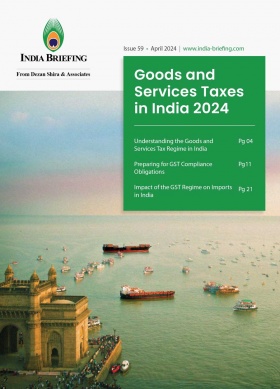A Guide to Minimum Wage in India in 2025
Foreign businesses in India can have a challenging time comprehending and calculating the minimum wage as they differ in every state, and are categorized under multiple criteria, such as region, industry, skills level, and nature of work.
This article will address some frequently asked questions, including how minimum wages are calculated in India, what is the penalty for non-compliance, and what are some useful resources that hiring departments in foreign companies may refer to when assessing the country’s labor costs.
How is the minimum wage calculated in India?
It must be noted that India’s minimum wage and salary structure differs based on the following factors: state, area within the state based on development level (zone), industry, occupation, and skill-level. This offers foreign investors a range of options when choosing where to locate their set up.
India uses a complex method of setting minimum wages that defines nearly 2,000 different types of jobs for unskilled workers and over 400 categories of employment, with a minimum daily wage for each type of job. The monthly minimum wage calculation includes the variable dearness allowance (VDA) component, which accounts for inflationary trends, that is, the increase or decrease in the Consumer Price Index (CPI), and where applicable, the house rent allowance (HRA).
As mentioned earlier, the calculation of the minimum wage factors in the skill-level of the worker and the nature of their work. Broadly, workers in India are categorized as unskilled, semi-skilled, skilled, and highly skilled. The minimum wage rates across Indian states and union territories must therefore be regularly tracked as they are subject to periodic changes, especially for the variable and dearness allowance rates.
How is the minimum wage regulated?
The minimum wage has for a long time been regulated under the purview of the Minimum Wages Act, 1948. This will be subject to the provisions of the Code on Wages Act, 2019, notified in August 2019, once it comes into effect across the country. At that time, the Code on Wages Act would replace four labor regulations – Minimum Wages Act, 1948; Payment of Wages Act, 1936; Payment of Bonus Act, 1965; and Equal Remuneration Act, 1976. The new wage code, once implemented, would prohibit employers from paying workers less than the stipulated minimum wage. Further, minimum wages would need to be revised and reviewed by the central and state government at an interval of not more than five years.
India is also mulling over the concept of establishing a ‘living wage’ by 2025, and is currently working with the ILO. A living wage would exceed the basic minimum wage as it will cover essential social expenditures, such as housing, food, healthcare, education, and clothing.
How to understand labor costs in India?
India boasts the most competitive labor costs in Asia, with a national-level minimum daily wage of approximately INR 178 (equivalent to US$2.13), translating to around INR 5340 (approximately US$63.97) per month. It’s important to note that this figure serves as the baseline wage, subject to adjustments based on factors, such as geographical location and specific criteria.
Regional disparities in minimum wage floors are evident in India. Geographically, the minimum wage can range from INR 160 (US$1.92) per day in Bihar to INR 423 (US$5.07) per day in Delhi, in accordance with the Minimum Wages Act of 1948. Specifically, the Kerala region stands out with the highest minimum daily rates for non-laborers, while other parts of the country maintain relatively uniform minimum wage levels for such workers.
|
Minimum Wages for States Across India (per month) (in INR) |
|||
|
State |
Unskilled |
Skilled |
Highly skilled |
|
Andaman and Nicobar Islands Effective date: July 1, 2024 |
16,458 |
21,762 |
23,920 |
|
Andhra Pradesh Effective date: April 1, 2024 |
13,248.50 (Zone I) |
15,248.50 (Zone I) |
15,748 (Zone I) |
|
Arunachal Pradesh Effective date: April 1, 2023 |
6,600 |
7,200 |
NA |
|
Assam Effective date: June 1, 2023 |
9,800.50 |
14,239.35 |
18,307.05 |
|
Bihar Effective date: April 1, 2024 |
10,660 |
13,494 |
16,484 |
|
Chandigarh Effective date: October 1, 2023 |
13,659 |
14,334 (I) |
14,734 |
|
Chhattisgarh Effective date: October 1, 2023 |
10,100 (Zone C) 10,360 (Zone B) 10,620 (Zone A) |
11,530 (Zone C) 11,790 (Zone B) 12,050 (Zone A) |
12,310 (Zone C) 12,570 (Zone B) 12,830 (Zone A) |
|
Dadra and Nagar Haveli Effective date: October 1, 2022 |
9,237.80 |
9,653.80 |
NA |
|
Daman and Diu Effective date: April 1, 2023 |
11,466 |
12,012 |
NA |
|
Delhi Effective date: April 1, 2025 |
18,456; |
22,411 |
24,356 |
|
Goa Effective date: October 1, 2023 |
13,598 (Zone A) |
16614 (Zone A) |
NA |
|
Gujarat Effective date: April 1, 2024 |
12,662 (Zone I) |
13,234 (Zone I) |
NA |
|
Haryana Effective date: January 1, 2024 |
10,924 |
12,646.12 (Class A) |
13,942.36 |
|
Himachal Pradesh Effective date: April 1, 2023 |
11,250 (I) |
13,062 (I) |
13,592 (I) |
|
Jammu and Kashmir Effective date: October 17, 2022 |
8,086
|
12,558 |
14,352 |
|
Jharkhand Effective date: October 1, 2023 |
9,162.11 |
12,652.78 |
14,615.83 |
|
Karnataka Effective date: April 1, 2024 |
15106.23 (Zone I) |
17,539.67 (Zone I) |
18,941.80 (Zone I) |
|
Madhya Pradesh Effective date: April 1, 2024 |
11,800 |
14,519 |
16,144 |
|
Maharashtra Effective date: January 1, 2024 |
13,089 (Zone I) |
14,700 (Zone I) |
NA |
|
Meghalaya Effective date: January 1, 2025 |
13,650; (semi-skilled) 14,690 |
15,730 |
16,770 |
|
Nagaland Effective date: June 14, 2019 |
5,280 |
7,050 |
NA |
|
Punjab Effective date: September 1, 2023 |
10,736.75
|
12,413.75 |
13,445.75 |
|
Rajasthan Effective date: July 1, 2021 |
6,734 |
7,358 |
8,658 |
|
Tripura Effective date: October 1, 2023 |
7,420.61 |
9,104.13-12,289.91 |
NA |
|
Uttar Pradesh Effective date: October 1, 2023 |
10,275 |
12,661 |
NA |
|
Uttarakhand Effective date: April 1, 2024 |
12,391-12,539 |
13,838-14,023 |
NA |
|
West Bengal Effective date: July 1, 2024 |
9,956 (Zone A) |
12,048 (Zone A) |
13,252 (Zone A) |
Source: Simpliance
Note: This is not a comprehensive table, and the respective state governments in India announce their minimum wage rates differently, that is, according to skill-level or other criteria. The criteria are either unskilled, semi-skilled, skilled, and/ highly skilled work categories or are occupation-based categories. For accurate and up-to-date information, companies are advised to consult local experts and official government sources in each state to ensure compliance with the latest minimum wage regulations.
Average minimum wage in India
Tracking by e-commerce firm Picodi.com showed that India’s average minimum wage in 2021 was US$95, much lower than the Southeast Asian markets of Vietnam (US$160), Thailand (US$220), and Malaysia (US$258).
Most media report that the average Indian salary for unskilled work ranges between INR 2250 (US$26.95) to a maximum of INR 70,000 (US$838.50) per month, under the Minimum Wages Act. However, the median monthly salary in India comes at around just INR 29,400 (US$352.17).
According to data released by World of Statistics on May 1, 2023, India has an average monthly wage of INR 46,861 (US$561.33).
These rates apply very differently among the respective industries – with higher salary wages reported in skilled professional services industries like software and consultancy work as compared to manufacturing and construction.
Minimum wages of unorganized workers
India’s central government revises the variable dearness allowance twice a year – from April 1 and October 1 – which is based on the six-month average increase in the Consumer Price Index for industrial workers. The latest hike announced will be effective from October 1, 2024.
|
Central Government Hike in Minimum Wages of Unorganized Workers [October 1, 2024] |
|
|
Category |
Area A minimum wage update |
|
Construction, sweeping, cleaning, loading and unloading for unskilled work |
|
|
Semi-skilled labor |
|
|
Skilled, clerical, and watch & ward without arms |
|
|
Highly skilled and watch & ward with arms |
|
Note: For information on the revised VDA rates announced September 25, 2024, by the Central Government, which will be effective from October 1, 2024, see the official notification here: https://clc.gov.in/clc/sites/default/files/mygov_17272659741.pdf
|
Minimum Wage Data for Central Government – April 1, 2024 (in INR) |
|||
|
Category |
Area A |
Area B |
Area C |
|
Sweeping and cleaning |
20,228 |
16,926 |
13,572 |
|
Watch and ward without arms |
24,648 |
21,412 |
19,084 |
|
Watch and ward with arms |
26,728 |
24,648 |
22,412 |
|
Construction, maintenance – unskilled |
20,228 |
16,926 |
13,572 |
|
Construction, maintenance – semi skilled/ supervisory |
22,412 |
19,084 |
15,806 |
|
Construction, maintenance – skilled/clerical |
24,648 |
22,412 |
19,084 |
|
Construction, maintenance – highly skilled |
26,728 |
24,648 |
22,412 |
India’s labor market size
Overall, India’s labor market size is above 471 million as per the World Bank. Consequently, several state governments, like Andhra Pradesh, offer tax breaks for companies generating local employment.
By 2030, it is estimated that India’s working age population would cross the 1-billion-mark, per a report from global consultancy major EY. This would effectively make India the largest provider of human resource assets in the world.
This youthful demographic not only strengthens India’s competitiveness in services and manufacturing but is also set to drive discretionary spending, as the purchasing power increases among the expanding youth population.
Delhi’s minimum wage
Minimum wage update: April 1, 2025
On April 15, 2025, the Delhi state government, current under the administration of Chief Minister Rekha Gupta, announced hike in monthly minimum wage across all categories of workers. Effective April 1, 2025, the monthly wage rates will be as follows:
- Unskilled: INR 18,456
- Semi-skilled : INR 20,371
- Skilled: INR 22,411
- Non-matriculate: INR 20,371
- Matriculate but not graduate: INR 22,411
- Graduate and above: INR 24,356
Minimum wage update: October 1, 2024
Delhi Chief Minister Atishi announced on September 25, 2024, that the Delhi government has revised minimum wage rates.
Effective October 1, 2024, the monthly wages for unskilled workers in Delhi will rise from INR 17,494 to INR 18,066. For semi-skilled workers, wages will increase from INR 19,279 to INR 19,929, while skilled laborers will see their pay rise from INR 21,215 to INR 21,917. Additionally, the government has raised the minimum wages for supervisory and clerical positions, including those for matriculate, non-matriculate, and graduate employees.
2023-24 rates
The state government had revised minimum wage rates effective from October 1, 2023. The minimum monthly wages of unskilled workers had increased from INR 17,234 (US$206.44) to INR 17,494 (US$209.55), semi-skilled workers from INR 18,993 (US$227.50) to INR 19,279 (US$230.93) and skilled workers from INR 20,903 (US$250.39) to INR 21,215 (US$254.12).
The minimum wage rates for supervisor and clerical categories of employees had been revised by the city government. The minimum monthly wages of employees who have not completed their Grade 10 schooling (non-matriculate) was increased from INR 18,993 (US$227.50) to INR 19,279 (US$230.93) and for matriculate employees from INR 20,903 (US$250.39) to INR 21,215 (US$254.12).
For graduates and those with higher educational qualifications, the monthly wages were hiked from INR 22,744 (US$272.44) to INR 23,082 (US$276.49).
|
Monthly Minimum Wages in Delhi as of April 1, 2025(in INR) |
|||||
|
Class of employment |
Wages (October 1, 2023) |
Hike |
Wages (October 1, 2024) |
Hike |
Wages (April 1, 2025) |
|
Unskilled |
17,494 |
572 |
18,066 |
390 |
18,456 |
|
Semi-skilled |
19,279 |
650 |
19,929 |
442 |
20,371 |
|
Skilled |
21,215 |
702 |
21,917 |
494 |
22,411 |
|
Clerical and supervisory staff (non-matriculate) |
19,279 |
650 |
19,929 |
442 |
20,371 |
|
Clerical and supervisory staff (matriculate but not graduate) |
21,215 |
702 |
21,917 |
512 |
22,411 |
|
Clerical and supervisory staff (graduates and above) |
23,082 |
754 |
23,836 |
520 |
24,356 |
|
Daily Minimum Wage in Delhi (in INR) |
|
|
Category |
Daily rates (as of April 1, 2025) |
|
Unskilled |
710/- |
|
Semi-skilled |
784/- |
|
Skilled |
862/- |
|
Non-matriculate |
784/- |
|
Matriculate but not graduate |
862/- |
|
Graduate and above |
937/- |
Meghalaya revamps minimum wage; enhance worker benefits
Is there a penalty for non-compliance?
Once the new wage code is implemented, the government will appoint inspectors-cum-facilitators to carry out inspections to ensure that the companies are compliant with the code. The penalty would depend on the nature of the offense. The maximum penalty is imprisonment for three months and/or a fine of up to INR 100,000 (US$1,197.85).
It is important that companies are compliant with the wage norms stipulated by the respective state government and industry body. Inspections are likely to be more stringent on companies with foreign investment, especially in the event of any labor unrest.
If workers are paid less than the government declared minimum wages, then they can file a complaint with the labor inspectorate. The complaint can be filed individually by the worker, or through a lawyer, or through an official of the registered trade union.
Why India has no national minimum wage
Under the Code on Wages Act, 2019, workers from all industries are entitled to receive minimum wages fixed by their respective state governments. Matters concerning labor and its welfare come under the purview of, both, the state and central governments as per constitutional law, thereby resulting in multi-jurisdictional regulation.
Earlier, only workers from a particular set of industries (40 percent of the entire workers’ population) were entitled to receive minimum wages. Nevertheless, since passing the wage code in 2019, there has been no new development on implementing a national minimum wage for Indian workers.
The government has not prioritized the implementation of a minimum wage plan as it is highly polarizing and would adversely impact employers in the post-pandemic period.
Labor law reforms
Besides addressing wage standards in the country, key labor legislation have also been rolled out as promised by the central government in the pursuit of labor reforms. Three new labor codes were approved by India’s parliament on September 22-23, 2020, in a historic move to consolidate the country’s multiple labor legislation and compliance norms. The new codes are – Industrial Relations Code Bill, 2020; Code on Social Security Bill, 2020; and the Occupational Safety, Health and Working Conditions Code Bill, 2020.
The implementation of the labor codes are, however, deferred until all states notify implementing rules. As things stand, this may not happen until after the 2024 general elections. The government is keen to ensure consensus among all stakeholders to avoid economic disruptions, such as industrial strikes.
When they come into force, the four labor codes will bring gig workers and inter-state migrant workers into the ambit of social security for the first time. This will impact minimum wage considerations, but businesses should note that they will also make it easier to be flexible in their hiring and firing decisions as well as in shutting down operations in the country.
For more analysis, read our overview – India’s New Labor Codes: A Brief Note for Foreign Investors; and deep dives – India’s New Industrial Relations Code and its Impact on Labor Law and India’s Occupational Safety, Health and Working Conditions Code, 2020: What is it and How Should Companies Prepare?
Seeking local expertise is important
Foreign entities doing business in India can learn more about the minimum wages in India through the Ministry of Labor and Employment database, which provides industry-wise wage norms. The new wage code can be accessed here, and the website for the chief labor commissioner can be accessed here.
Since determining wages in India is complex, and labor compliances are carefully monitored, it is recommended to seek advice from a local firm to assess costs and other liabilities. Otherwise the firm may be exposed to additional risks during times of labor unrest and strikes by workers that can lead to reputational and financial damage to the company.
(US$ 1 = INR 83.48)
For more information and advice for foreign investors on doing business in India, please feel free to email us at india@dezshira.com.
(This article was originally written on January 22, 2020. It was last updated May 21, 2025.)
About Us
India Briefing is one of five regional publications under the Asia Briefing brand. It is supported by Dezan Shira & Associates, a pan-Asia, multi-disciplinary professional services firm that assists foreign investors throughout Asia, including through offices in Delhi, Mumbai, and Bengaluru in India. Readers may write to india@dezshira.com for support on doing business in India. For a complimentary subscription to India Briefing’s content products, please click here.
Dezan Shira & Associates also maintains offices or has alliance partners assisting foreign investors in China, Hong Kong SAR, Dubai (UAE), Indonesia, Singapore, Vietnam, Philippines, Malaysia, Thailand, Bangladesh, Italy, Germany, the United States, and Australia.
- Previous Article FTAs and FDI Fuel Expansion in India’s Luxury Car Segment
- Next Article BCI’s Revised Rules Expand Scope for Foreign Lawyers in India: What You Need to Know








